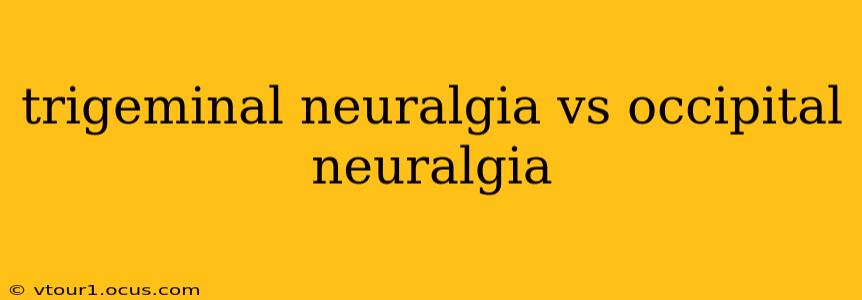Trigeminal neuralgia and occipital neuralgia are both types of neuropathic pain, meaning they result from damage or dysfunction of the nerves. While both cause intense, often debilitating pain, they affect different parts of the head and have distinct characteristics. Understanding these differences is crucial for accurate diagnosis and effective treatment.
What is Trigeminal Neuralgia?
Trigeminal neuralgia (TN), also known as tic douloureux, is a chronic pain condition affecting the trigeminal nerve, the fifth cranial nerve. This nerve carries sensation from your face to your brain. The pain is typically described as a sharp, stabbing, electric shock-like sensation that comes in sudden, intense bursts. These episodes can last from a few seconds to several minutes. The pain is usually felt in one side of the face, often affecting the cheek, jaw, or forehead.
What Causes Trigeminal Neuralgia?
The exact cause of trigeminal neuralgia isn't always clear, but it's often linked to compression of the trigeminal nerve by a blood vessel or tumor. Multiple sclerosis (MS) can also be a contributing factor. Sometimes, no identifiable cause is found.
What is Occipital Neuralgia?
Occipital neuralgia is a type of headache characterized by severe pain in the back of the head and neck. It's caused by irritation or damage to the greater and lesser occipital nerves, which supply sensation to the scalp. The pain can be described as sharp, burning, or stabbing, and it often radiates from the back of the head to the forehead, temples, or behind the eyes.
What Causes Occipital Neuralgia?
Several factors can contribute to occipital neuralgia. These include:
- Muscle strain: Tight neck muscles can compress the occipital nerves.
- Trauma: Injuries to the head or neck, such as whiplash, can damage the nerves.
- Arthritis: Arthritis in the neck can irritate the nerves.
- Infections: Viral or bacterial infections can sometimes inflame the nerves.
- Less common causes: Tumors or other structural abnormalities can also play a role.
Trigeminal Neuralgia vs. Occipital Neuralgia: Key Differences
| Feature | Trigeminal Neuralgia | Occipital Neuralgia |
|---|---|---|
| Location | Face (cheek, jaw, forehead) | Back of head, neck, radiating to forehead, temples, eyes |
| Pain Quality | Sharp, stabbing, electric shock-like, sudden bursts | Sharp, burning, stabbing, often constant or in waves |
| Trigger Points | Often triggered by light touch or specific actions | Often triggered by neck movement or pressure on the neck |
| Associated Conditions | Multiple sclerosis | Neck injuries, arthritis, infections |
| Affected Nerve | Trigeminal nerve (CN V) | Greater and lesser occipital nerves |
How are Trigeminal Neuralgia and Occipital Neuralgia Diagnosed?
Diagnosis typically involves a detailed neurological examination and a review of the patient's medical history. Imaging tests like MRI or CT scans may be used to rule out other conditions. For both conditions, a thorough patient history describing the type, location, and triggers of the pain is crucial.
What are the Treatment Options?
Treatment options for both trigeminal and occipital neuralgia vary depending on the severity of the pain and the underlying cause. They may include:
- Medications: Pain relievers (e.g., NSAIDs), anticonvulsants (e.g., carbamazepine), antidepressants (e.g., amitriptyline).
- Injections: Botox injections or steroid injections can provide temporary relief.
- Surgery: In severe cases, surgical options may be considered.
- Physical Therapy: For occipital neuralgia, physical therapy can help address muscle tightness and improve neck mobility.
How Can I Tell the Difference Between Trigeminal and Occipital Neuralgia?
The location of the pain is the most significant differentiator. Trigeminal neuralgia affects the face, while occipital neuralgia affects the back of the head and neck. However, only a medical professional can definitively diagnose these conditions. If you experience severe, persistent pain in your head or face, it is crucial to seek medical attention for proper diagnosis and treatment.
Disclaimer: This information is for educational purposes only and should not be considered medical advice. Always consult with a healthcare professional for diagnosis and treatment of any medical condition.
